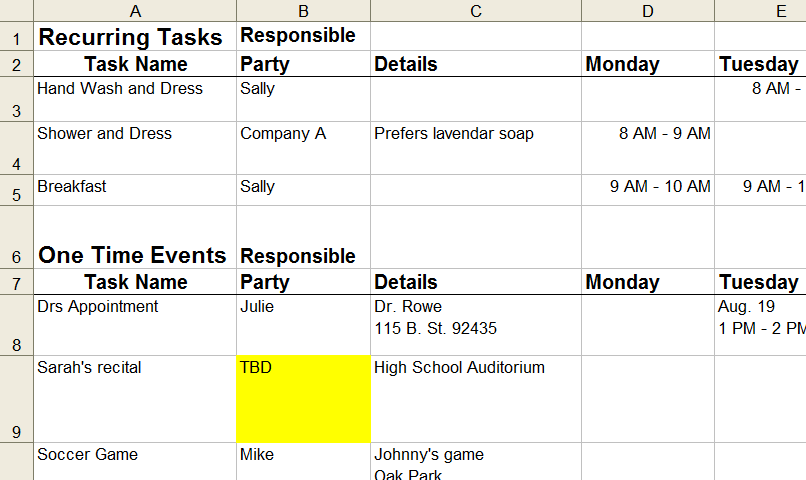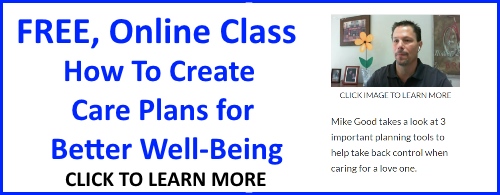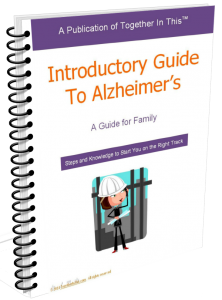Identifying and filling gaps in the care plan is the final component as discussed in my article, How to Create a Patient Daily Care Plan. It is also the most complicated.
Once in place, however, it will benefit anyone with health care needs, whether they are rehabilitating from an accident or have a progressive illness such as Alzheimer’s disease.
To accurately complete this component, you must work with everyone that you have identified as being part of the care circle (resources). Some people will be hesitant to commit and others will over commit.
So, you as the project manager will need to adjust the plan throughout the process based on everyone’s actual input.
In my article, How to Perform an Evaluation of the Care Recipient, I discussed how to develop a list of needs (tasks) and resources. If you did not do this, you will need to before you will be able to complete this process.
We will now work with the data you generated.
 Layout the tasks/needs
Layout the tasks/needs
At Together in This, I have created a planning worksheet to help you get started.
Here is the worksheet: Daily Care Plan worksheet
You can print and use this worksheet or you can recreate your own system using a computer spreadsheet or something similar. Just remember that you need something that is easy to modify and share with others in the care circle.
Here is a snapshot of the worksheet (the actual worksheet shows a more detailed example):
The worksheet is 10 columns wide, labeled A – J. The amount of rows will vary depending on the number of tasks (needs) that you have identified.
Notice that the worksheet has two major sections: 1) Recurring Tasks and 2) One Time Events. Recurring tasks include tasks that occur regularly if not daily. These are tasks such as lunch or exercise. One-time events include things such as an appointment, birthday, or a family member’s soccer game.
Column A is for the task name. Here you input all of the tasks that you previously identified. You will want to put them in sequential order in their appropriate sections; i.e. recurring vs. one time events.
Column B is where you identify the person or organization responsible for completing the task.
Column C is for any details that will help make the completion of the task successful. Patient preferences or addresses of appointments are examples.
Columns D – J are for the days of the week. In these blocks, you put the date, time, and duration of all tasks and events.
As you continue to complete the worksheet, you may start to see gaps in care. Resist the temptation to put your name next to the gaps. Work to fill these gaps with other resources. As the primary caregiver, you are invariably going to see your name next to the majority of tasks already.
Be sure that you include some “me time” in this plan
Failure to adhere to this rule will put the long-term success of this plan at risk because your health will suffer. If you are not taking care of yourself, the quality of care you give your loved one will suffer as well.
No plan is perfect
A plan’s success is measured by one’s ability to adjust the plan when unforeseen challenges, resource limitations, or behavioral changes arise. When dealing with a disease such as Alzheimer’s which erodes a person’s abilities, each day will be different and the patient’s lucidity may change from minute to minute.
What works one day, may fail miserably the next, but then work again next week.
The care plan should not be rigid
It should be quite the opposite – it must be flexible. Remember, the whole purpose of the daily-care plan is to insure the safety and well being of your loved one. If it’s not working, you must be willing to modify the plan. Flexibility, creativity, and adaptation, are all key to success.
Review and update the care plan regularly
In order to ensure the plan is working, you must perform regular reviews and updates with the care circle. In the beginning, as you get it “dialed” in, this will probably happen very often. But as things get going, the duration between reviews can increase.
It will be up to you to determine the review schedule. I highly recommend that you assign someone to nudge you periodically to ensure that the reviews are being completed. We all become complacent, but as the caregiver, you will likely be overwhelmed at times.
You will find yourself being reactive and not proactive. So a friendly nudge should be a welcomed thing.
During the review process, you not only need to evaluate the current situation but anticipate what changes may occur. This is especially true when caring for someone with a progressive illness such as dementia.
For instance, maybe mom is still cooking but you are starting to worry about her interaction with the gas stove. As a result, you may need to plan to have someone help prepare meals. Or, suppose you are still maintaining a career but dad needs more help during the day.
Your plan needs to anticipate these changes so that you can arrange the finances for hiring paid help to supplement your efforts.
If your loved one has Alzheimer’s disease, I recommend you acquaint yourself with the 7 stages of Alzheimer’s. Remember, however, that each person progresses through the disease differently, so don’t look at these stages with rigid expectations. Use them to be aware of what will eventually occur.
These stages also focus on loss, but you want to have a focus on what abilities remain. This reframing of how we see the progression is important to maximizing you’re loved one’s well-being.
And with Alzheimer’s disease, remember:
Nothing is routine
There is little to no stability
Every patient and situation is different
Practice patience, love, and adaptation
For all caregivers, having a flexible, maintained plan, will help keep your loved one safe while maximizing their physical and mental well-being.
This completes my series on Patient Care Plans – A Vital Tool for Caregiving. Thank you very much for reading my articles.
If you like what you’ve read, why not receive periodic updates when you:
Subscribe to the TinT Newsletter
Questions, comments, or perhaps other ideas? In the comments below, I would love to hear from you.
Legal: This website is provided as a service. The material and information available on TogetherInThis.com is provided without any guarantees, conditions, or warranties as to its accuracy. The information is provided as an information resource only, and is not to be solely relied on for any legal, financial, diagnostic, or treatment purposes. At all times, the proper professionals should be consulted. Together in This does not accept any responsibility for any loss which may arise from reliance on information contained on this site.








Leave a Reply